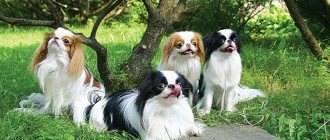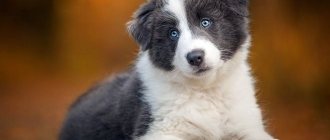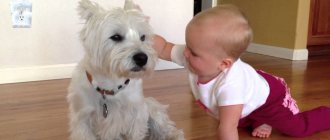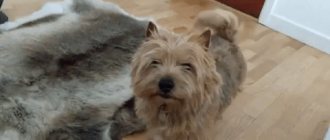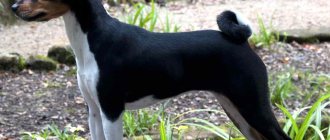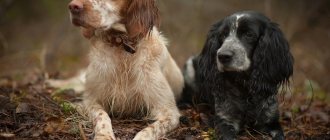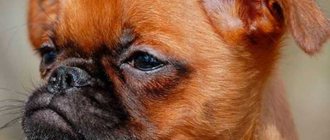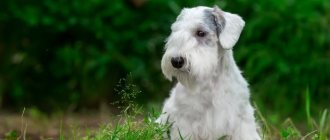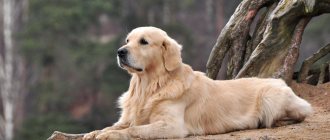“How poor and ugly I am.
« WE'LL GET YOUR NORWICH OR NORFOLK IN ORDER:
Phone:
“I spent six months growing my fur! Do not touch !"
COAT CARE FOR NORFOLK AND NORWICH TERRIERS.
Grooming the Norfolk and Norwich Terrier is a relatively easy task if you have the patience it takes to “pluck” the dog and, most importantly, an eye. To make it beautiful. Look what the same dog looks like - not well-groomed and after trimming.
TOOLS for trimming. There are thousands of terrier grooming tools available. But most of all, the following are needed: 1. A metal comb with a rare and frequent tooth (for daily use). 2. Massage brush or terrier brush (with straight metal teeth) 3. Natural bristle brush (for daily combing, applying oil, etc.) 4. Slicker brush (for face, paws). 5-6. Trimming - coarse and fine - a special knife for removing hair. 7. Stripper (for quickly removing overgrown hair). 8. Scissors with a blunt nose (for cutting hair between the pads, in the ears..). 9. Hairdressing scissors (for processing the bottom of the paws, anus...). 10. Forceps or tweezers (for removing hair from the ear..). 11. Nail clipper (for cutting nails). You may also need: a special trimming table with a non-slip surface and a tripod for fixing the dog, a scaler for removing tartar, a hair dryer, thinning scissors, trimming and ear powder, etc.
CARE OF YOUR COMPANION DOG'S HAIR .
The Norfolk or Norwich companion dog's coat needs to be completely brushed at least once a week. Bathe your dog as needed to keep your dog and home clean. The dog should be plucked by hand once in the Spring and once in the Autumn. If you do not plan to show the dog, then scissoring around the paws and genitals saves significant time. Weekly brushing, essentially removing dead hair and the longest hairs with a rough trim, will easily keep your dog's coat in good condition.
SHOW DOG HAIR .
The other opposite is the exhibition display. It requires a lot more effort and understanding of the breed standard, and the dog's functions, to get the perfect image. Longer hair is not necessarily better. In fact, less hair often looks like more when done correctly. Hair lengths of approximately one to two inches on the body look best on dogs. The coat of black and tan terriers is the coarsest, while red, red-red, etc. are softer. Black and tan Norfolk Terriers look better with shorter coats than red ones, or they look unkempt. But this is not true for Norwich. In general, Norwich wool is stiffer and less difficult to roll. The coarsest wool is generally the most difficult to grow. Depending on the dog, the show coat is best maintained if the entire dog is groomed once a week. Allowing time between plucks allows the dog to grow layers of coat for hand plucking each week. Ultimately, this allows the wool to “roll” (in Russian this is called “rolling”). Rolling wool, instead of being all one length, has many layers. The main layer is the longest layer. As soon as this layer becomes too long, it is pulled out or “trimmed”. Waiting a few weeks between trims makes the layers more obvious and easier to match. The layers below the longest layers are not quite ready to stretch to show the healthy, wiry coat growing below. The different layers provide the look with a dense and vibrant coat. You can look at the beautiful SHOW TRIM here EXHIBITIONS or here THE MOST FAMOUS NORWICHES.
Norwich Terrier - a dandy and a bully in a shaggy fur coat
The history of the origin of the breed began more than a hundred years ago in the distant English county of Norfolk, suffering from an invasion of rodents in peasant barns. Farmers desperately needed a small, brave dog that could cope with hordes of rats and mice destroying grain supplies. To develop the breed, an English black and tan terrier was used, to which the blood of local varieties of wire-haired hunters was added. As a result of “folk selection”, a small brave dog appeared, ideal for guarding granaries:
- Thanks to its small stature, short legs and elongated chest, the Norwich easily slipped into small cracks under barn doors, and was also successfully used in hunting as a burrowing dog.
- The hard, shaggy coat and thick undercoat protected the dog from thorny bushes and bites.
- Strong, large, tightly set teeth made it possible to cope not only with a harmless mouse, but also with a seasoned rat or badger in a hole.
- Tirelessness and cheerful disposition made such a terrier an ideal friend for the average English farmer or hunter, forced to work a lot during the day and having no other entertainment except playing with the dog.
This is interesting: Catherine Zeta Jones in her youth
Gradually, these small active rat catchers became increasingly popular not only in their historical homeland, but throughout the world. It's funny that for a long time no one called the breed by its real name, calling the dogs simply rags, which translated from English means shaggy or disheveled.
The Cambridge Terrier is another name by which the Norwich was widely known among English students. This nickname stuck to them as a result of their popularity among students of the educational institution of the same name. Small cheerful dogs were faithful friends of carefree young people and at one time were even considered the mascot and unofficial symbol of the university.
The second topic, about which heated debates arose more than once, concerned the placement of ears. In the county of Norfolk itself, animals with erect and hanging ears were equally actively involved in breeding. The debate about which set was preferable did not subside until 1964, when the English Kennel Club solved the problem quite ingeniously by dividing all the livestock into two different breeds - Norwich with erect ears and Norfolk Terriers with drooping ears.
During the Second World War, the number of Norwich dogs declined rapidly, and only thanks to the enthusiasm of breed lovers and the influx of Irish and Bedlington terrier blood, cheerful and funny Rags again appeared in the rings of the world's largest exhibitions.
Description
It’s hard to call the Norwich Terrier a decorative animal: the dog has developed muscles, strong bones, compact parameters and stockiness. Females differ slightly from males in size. The height at the withers is 24-26 cm, weight is 5-5.5 kg. Life expectancy can reach 16 years.
The head seems larger than the body, but this is an illusion: this part of the body has thicker hair and is distinguished by smooth lines. The skull is circular in shape and thickened in the forehead area. The muzzle is wedge-shaped, longer than the head, with a sharp transition. The nose is black, the lips are dense and have dense pigmentation.
The ears are medium-sized, stand up, have a triangular shape with pointed ends, and are located quite far from each other. In an excited state, the ears are directed forward and raised; in a calm state, on the contrary, they move back. The eyes are black or dark brown, oval in shape, and small in size. The structure of the skull is such that these organs seem to sink, which in a way protects them. The dog looks at the world cheerfully and interestedly. The teeth are firmly set, large, and the jaws have a scissor bite. The length of the neck is harmoniously correlated with other parameters of the body.
The body is rectangular, and the bones, although flexible, are strong. The narrow chest allows the pet to crawl into holes or other places. The groin and belly are tucked in, and the back and lower back are short. The tail can be docked, but it is possible to do without surgery - the standard allows both forms. An undocked tail has no limitation in length; it is thicker at the base and tapers towards the tip. The docked organ is of medium length and is perpendicular to the ground when moving.
The front legs are less muscular than the hind legs, which have well-developed muscles. Both pairs of limbs are well developed, strong, and push off the ground strongly. The coat is hard, wire-like in structure, and bristles. The head is covered with smooth short hair, except for the area near the eyes and mouth. The dog has a thick undercoat. The following color varieties exist:
- Pale yellow.
- Rich red.
- Black with reddish tan (black and white).
- Gray-haired (“grizzly”).
The following characteristics are not recognized by the standard:
- Weakness of the hocks or stifles.
- Curled or excessively long tail.
- Long muzzle.
- The muzzle bones are too thin.
- Protruding or round eyes.
- Weak muscles in the neck.
- White spots.
- A barrel-shaped chest.
- Direct bite.
- Amble.
- "Hare" feet.
- Soft lips.
A dog will definitely be disqualified if it is found to have:
- Aggression or cowardice.
- Cryptorchidism in males.
- Light eye color.
- Overshot or undershot.
Character
Fearless little rat catchers are still extremely popular today, one and a half hundred years later, among lovers of the cheerful terrier brotherhood. However, for those who have decided to get themselves a Norwich, it would be nice to know about some features of his character:
- Friendliness . Norwich Terriers get along well with all family members, including small children. The main thing is to explain to kids that the dog should be treated with care and respect, without hurting it or being intrusive. Small, cheerful terriers are often adopted as companions to another, larger dog. Norwiches, despite their small size, consider themselves large and formidable dogs, and their strong bones allow them to safely participate in joint games even with a giant relative.
- Activity and tirelessness . A worthy representative of the energetic brotherhood of terriers, Norwich cannot imagine his life without movement and games. Don’t be fooled by your pet’s small stature and imaginary decorativeness. Norwich Terriers need full walks and serious training designed to make the dog more manageable and establish contact with the owner.
- Independence and high intelligence . Norwiches are fairly self-sufficient dogs that will not whine in the absence of their owner or damage furniture out of boredom. If you do not provide your pet with a long walk and adequate mental exercise, your four-legged friend will engage in more intellectual activities in your absence. For example, he will figure out how to open the refrigerator door or climb onto a table, a height unthinkable for his short legs. Constantly keep your animal's lively and inquisitive mind occupied by training or learning new skills, then your Norwich will calmly wait for you from work, without feeling lonely.
- Developed hunting instinct . The voice of their ancestors, winners of barn rats and furious badgers, still sounds quite loudly in the souls of representatives of this breed. Lacking enemies to fight, terriers begin to hunt neighbor's chickens or cats. Moreover, they show maximum ingenuity when trying to get to the prey - they make clever digs into a neighbor’s plot or dizzying jumps over obstacles.
- Easy to care for . The hard bristling coat of the Norwich, like a shell, protects it not only from scratches, but also from excessive pollution. Most of the dust falls off the hard coat on its own, and the rest is removed by simple combing. In addition, the coat of dogs of this breed does not shed or emit an odor, and everyday grooming is simple and even the owner can do. It is enough to regularly comb and keep in a roller, regularly plucking the undercoat and dead hair, coat. Of course, preparing for an exhibition requires professional trimming, which is best done by a professional groomer.
This is interesting: Eye Patches How to Use Correctly
General information
Trimming and stripping procedures
Essentially, these two concepts mean the same thing. Some people believe that trimming and stripping are the same hair removal procedure. Others believe that stripping is the removal of both guard and outer hair, while trimming is the removal of only outer hair. Groomers recommend carrying out the stripping procedure no more than twice a year.
Who needs stripping?
Most dog breeds (both short-haired and long-haired) shed twice a year. This happens in spring and autumn. Veterinarians and groomers recommend brushing your dogs daily with a special furminator brush at this time of year.
Wire-haired dogs do not shed. Their hair does not fall out, but new hair continues to grow. Therefore, such dogs need help. They need a stripping procedure to make them look well-groomed. Among these breeds are fox terriers, schnauzers, griffons and others.
NOTE! The stripping procedure is performed for the first time at the age of 6-8 months. Puppies should get used to this much earlier than this age.
Health
Here is a list of hereditary or acquired diseases that are most often found in representatives of this breed:
. This genetic pathology is nothing more than a dislocated knee. The main symptom of the disease is sudden lameness in animals older than 4 months. Depending on the severity of the disease, falling on the leg can go away after a short period of pacing or remain for a long time, significantly reducing the animal’s motor activity. In order to ensure a full-fledged existence for the pet, the owner must strictly observe a special regime of maintenance. Doctors also recommend the use of chondroprotectors and anti-inflammatory drugs to reduce wear and erosion of the knee joint.
Patella- Epilepsy . Disturbances in the processes of inhibition and excitation of the brain lead to the occurrence of convulsive attacks in the dog, which are repeated with traceable frequency. Despite the fact that hereditary epilepsy has no cure, the owner can make life much easier for the pet and even achieve stable remission.
- Tracheal collapse . This disease most often manifests itself as a sudden cough that worsens after the pet is excited or physically overworked. Such symptoms occur due to anatomical deformation of the tracheal rings, leading to a narrowing of the respiratory lumen. Contact between the walls of the trachea can cause not only coughing, but also more serious consequences, including suffocation and death of the animal. If your pet is diagnosed with such a genetic defect, doctors recommend minimizing the impact on the neck area as much as possible using a collar or ring, and also protecting your pet from various diseases of the upper respiratory tract. In especially severe cases, surgical intervention and installation of a special stent that takes the shape of the trachea is used.
- Obesity . Excellent appetite and the absence of gastrointestinal problems lead to the fact that the body weight of Norwich Terriers is often significantly higher than normal. Lack of physical activity and feeding the dog foods rich in fat also contribute to weight gain. To extend the life of your four-legged friend and protect him from a whole bunch of diseases associated with excess body weight, we recommend monitoring his figure and not giving the animal scraps from the human table.
- Rabies . The frantic temperament of a desperate rat catcher and fox hunter forces the Norwich Terrier to constantly look for its prey, trying to catch a variety of living creatures that it meets on its way. Hunting your neighbor's chickens or cats may cost you a fine, but if a Norwich resident catches a wild animal in his teeth, it risks contracting a dangerous disease such as rabies. Do not forget about your dog’s routine vaccinations and, if possible, limit your dog’s contact with wild representatives of the animal world.
- Dental problems . Large, tightly set teeth are the pride of Norwich Terriers. However, such a formidable weapon requires careful care - regular cleaning with a special brush or a regular bandage wrapped around the owner’s finger. Neglecting preventive procedures can lead to the formation of tartar in your pet and the appearance of bad breath.
The amazing intelligence and nobility of dogs of this breed, coupled with the fiery terrier temperament, allow them to surprise and delight the owner throughout their dog life. They say that those who once met a charming Norwich will never exchange him for any other breed.
Overexposure
Payment for foster care is discussed with a veterinarian, dog handler, and volunteer. Depending on the purpose of the overexposure, prices will differ. If the dog undergoes a general training course, he remains in the care of dog handlers who observe and care for him. Overexposure costs 20,000.
Training is carried out by dog handlers. The course price includes meals and care. By the end of OKD, the puppy will be able to carry out basic commands, will be socialized and will learn to interact with people. You can invite a dog handler or training specialist to your home. This reduces the amount of costs associated with training by 50-60%.
Based on average prices, you can derive general indicators and create a monthly schedule of expenses for each year. Before buying a dog, you need to calculate the costs associated with it and follow the results. But you also need to take into account unplanned expenses.
Purchasing a dog should be considered and agreed upon with family members. It is advisable for an inexperienced dog owner to enlist the help of an expert or become thoroughly familiar with the standard of the chosen breed. A pet can be purchased through an advertisement website, in a nursery, and also “from hand” in zoological markets, each method has its own characteristics.
Norwich Terrier
Like many other relatively young breeds, the Norwich Terrier was developed in the British Isles in the 19th century. This breed was specially designed for hunting in the specific environmental conditions of East Anglia, its homeland is Norfolk. It was soon discovered that the Norwich Terrier had the talent of a ratter, that is, a rat catcher. This began the growth in popularity of the new terrier breed; farmers got these dogs to protect their harvest. But the Norwich Terrier became truly popular after the University of Cambridge chose its image as its symbol.
Features of the Norwich Terrier breed
Externally, the Norwich Terrier resembles a Yorkie, this is not surprising, because both breeds have common ancestors. Norwich Terriers specialize in hunting rodents and burrows, so they must be very compact in size. The maximum weight that dogs of this breed can reach is just over 5 kg, and the height at the withers is 26 cm. Terriers are distinguished by fairly developed muscles, the dogs are very active and love games, they make excellent companions.
This is interesting: Wedding dresses 2022 fashion trends
Where can I find a Stripping specialist?
Today, the majority of groomers deal with dogs of all breeds, but everyone has their own favorites. This is either a breed that he owns or that he likes more than others. It is with this breed that the groomer spends more time working and improving his skills. Therefore, it is useful to find out in advance which breeds the groomer specializes in. It happens, of course, that a master is a generalist, but this is extremely rare!
The groomer's specialization in one breed is noticeable in cases where the groomer was a breeder of a certain breed for many years, and then started another. They seem to be similar, but there are also differences. And it is precisely at such a moment that you notice that no, no, yes, grooming will slip through - either the head or the body from another breed.
As a result, if you are not planning a show career for your dog, then move on to the article Grooming, groomer - what is it and who is it? and choose a groomer.
But if your pet’s career will grow in the rings, then try to choose a master who deals specifically with your breed. This way you are guaranteed to receive breed standard grooming and save your mustachioed friend’s nerves. And the judges will appreciate the appearance of your Champion!
We invite owners and beloved pets to our Zoo Salon - We specialize in trimming (stripping, plating) of all hard-haired dogs. Show, breed or salon options are possible.
For those who want to have an eternal source of positivity and at the same time a best friend, the Norwich Terrier is suitable. Small hunters have many advantages, but they also have difficulties. All this needs to be taken into account before getting a dog at home.
Grooming
The Norwich Terrier is a short-haired dog; the layer of undercoat fluff is very poorly developed in its coat, and the hair itself is short and quite hard. Thanks to these features, caring for the coat does not require much effort. However, it is necessary to brush your pet regularly. The coat needs to be brushed at least once a week. Without regular brushing, dead hairs, dust and dirt will linger in your pet's coat for a long time, which can lead to skin inflammation. For combing, you should use a massage brush with hard teeth, for example, a steel one.
Thanks to its short coat, the dog can only be bathed a couple of times a year. More frequent bathing can lead to a decrease in the dog’s immunity, because during water procedures the protective fat layer is washed off from the bulldog’s skin and coat. Therefore, the dog should be bathed again only if it is heavily soiled.
Simple care for a Norwich Terrier
Norwich Terriers have historically been very good at chasing and hunting other animals. The hunter's instinct is present in these small dogs to this day, so if you get yourself a Norwich Terrier, you should not let him off the leash or lose sight of him on a walk.
Also, these dogs, due to their instincts, perceive other animals aggressively and can attack them with barking. This problem can be smoothed out by training a Norwich Terrier, but you are unlikely to be able to achieve the complete disappearance of innate instincts.
The same reason makes Norwich Terriers not the most suitable breed for living together with other animals in the house. The sooner the Norwich Terrier gets to know other pets in the house, the more likely it is that friendly relations will be established between them.
But the relationship between a child and a Norwich Terrier will not be a problem if the child respects the independence and intelligence of the Norwich Terrier.
